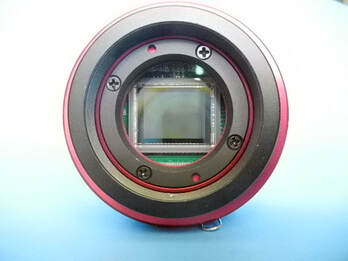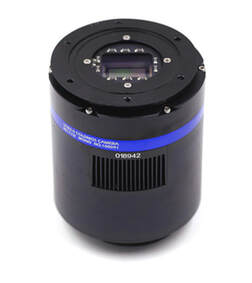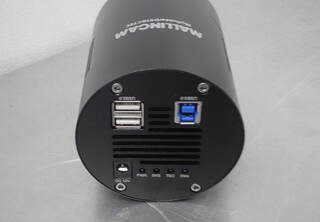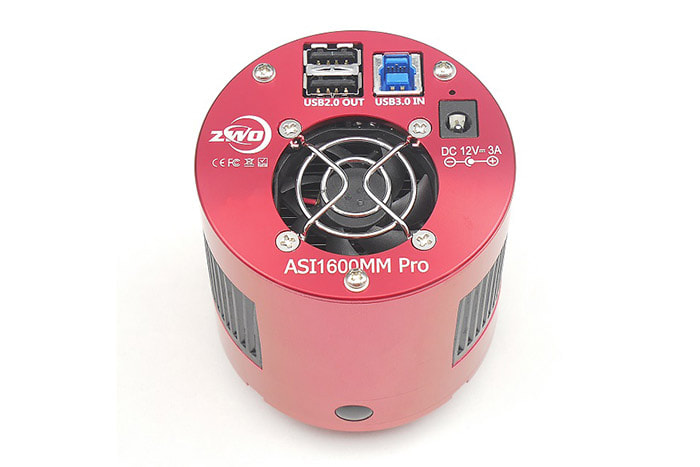 The introduction by ZWO of their camera, the ASI1600, in early 2016 has been a game changer for Camera Assisted Viewing (CAV), also known as Electronically Assisted Astronomy (EAA) or Near Real Time Viewing. This camera was the first astronomy camera to use Panasonic's latest CMOS sensor, the MN34230. The 4/3 format sensor has 16.3 Megapixels (4644 x 3506), each 3.8 microns square with a total chip size of 17.6 x 13.3mm. The larger chip size has a diagonal of 22mm which provides a much larger field of view compared to the cameras commonly used for CAV . Compare this to the analog cameras from Mallincam which have less than 0.5 Megapixels and diagonals of only 6 and 8mm depending upon the camera model. Even the recent CMOS cameras like the ASI224 only has 1.2 Megapixels and a diagonal of 6mm, much smaller than the ASI1600. And with 3.8 x 3.8 micron pixels it provides high resolution images for excellent image detail. Additionally, this sensor supports extremely low read-out noise on the order of 1 electron which made stacking many very short exposures much more practical. This reduces the demand on the quality of the polar alignment and the mount tracking for a successful CAV session. With such a large sensor and 16 million pixels, this chip supports binning 1x1, 2x2, 3x3 and 4x4 which trades resolution for sensitivity by making the "effective" pixel size larger. This is also useful in tailoring the image scale (arc-sec/pixel) to different optical setups.  Panasonic's new sensor was quickly incorporated into new cameras from ZWO, QHY, Mallincam and others and soon took the CAV community by storm making these the new hot cameras to have. ZWO was the first to incorporate this sensor into its ASI1600 camera which came in both uncooled Color ($699) and Monochrome ($899) versions. The uncooled color camera is now discontinued, but still can be obtained on the used market. They later came out with a cooled Monochrome version ($1280) called the Pro with 2 stage cooling down to -40deg, a 256MB DDR3 memory buffer to help avoid lost frames during high rate data transfers, a USB3.0 port and a USB2.0 Hub to connect accessories such as a filter wheel, guider and a focuser. The camera also has an autoguider port in case you want to use it as a guide camera.  QHY and Mallincam soon followed with similar cameras of their own incorporating this new Panasonic sensor. The QHY163 comes in color ($899) and monochrome ($1199) versions and also includes 128MB of DDR memory, a USB 3.0 interface, guide port, two stage cooling to -40C cooling and a sealed chamber with a heated window to prevent dew from building up. Mallincam's SkyRaider DS16 comes in 3 versions, color ($999), monochrome ($1299), both with a fan for passive cooling and TEC version ($1700 color, $1900 monochrome) with active cooling. They all have a USB 3 interface, a sealed chamber, DDR memory and a full featured software, Mallincamsky, for camera control, capture, live stacking and dark frame subtraction. The TEC version includes a USB Hub and a heated window for dew prevention. Both the ZWO and QHY cameras use the free software Sharpcap which performs all of the same functions as Mallincamsky and much more if you pay for the Pro version, but that is a topic for another blog. There are still more versions of cameras incorporating the Panasonic 4/3 chip, but I will not list all of them here.  These new cameras appear to have had two major impacts on the way we do real time viewing. First, if you read the threads on the Cloudy Nights forum, you will see that many amateur astronomers have moved away from the long exposures of 30 sec to minutes common with the security type astronomy cameras like the Mallincam Xtreme and Xterminator or the Revolution Imagers 1 and 2. With such low read-noise it is now practical to use programs like Sharpcap to stack many very short exposures of a few seconds on the fly to get as good or better image after 30sec to minutes but with less demand on the quality of the mount and the polar alignment. In fact, Alt-Az mounts become even more practical for CAV with such short exposures and the use of an on-the-fly stacking program. This can both minimize the cost of the setup and reduce the overall hassle in getting a good polar alignment. Obviously, a better mount and more time spent on a good polar alignment will improve the experience, but less so with exposures of 2 to 5 sec which is now practical with this new sensor. Second, since the pixels are square not rectangular stars are round unlike their appearance with CCD analog cameras and they do not have the black halo common to stars in images taken with analog cameras. Also, with pixels about 1/3 the size of the pixels in analog cameras much more detail can be seen in galaxies and nebular with the new sensor. Images obtained are of much higher quality than ever before. The net result appears to be a move by many CAV folks more and more in the direction of traditional astrophotography. It has become increasingly the case that dark frame subtraction and even flat frames are both employed with on-the-fly stacking to get the best possible image. The ideal case is to be able to view the image in real time to get the immediate enjoyment of observing deep sky objects, while saving individual frames for later post processing to obtain an astrophotography quality image. In fact this can be done with Sharpcap using the Live Stacking feature while selecting the option to save individual frames in FITs or PNG format for later post processing. As is always the case, time marches on and even newer products come to market. It appears that the successor to the ASI1600 is the ASI294 with the Sony IMX294 CMOS chip. It too is a 4/3 sensor with extremely low read noise. Even thought it has less pixels at 11.7 Megapixels, the major new advantage of the ASI294 is it's much deeper well which provides a significant advantage for dynamic range. Perhaps a topic for a later blog. I have been using the ASI1600MC for the last two years and am very happy with it. However, only the mono versions are still available. My astro buddy uses the ASI294MC color cooled version and has had great success with it. You can find the products listed in this blog in the links provided below. As an OPT Affiliate I can earn from qualifying purchases through my site with no additional cost to you. This helps to defray the cost of this website. ZWO ASI1600MM Uncooled - this is the mono version of the camera I have ZWO ASI1600MM Pro - cooled mono version of the camera I have QHY163 - QHY's cooled version of the color camera I have ZWO ASI294MC Uncooled - this camera is one of the most used cameras for EAA ZWO ASI294MC Pro - this is the cooled version of the 294 Revolution Imager II - analog camera which I have used and reviewed elsewhere
1 Comment
|
Categories
All
Archives
January 2024
|

 RSS Feed
RSS Feed